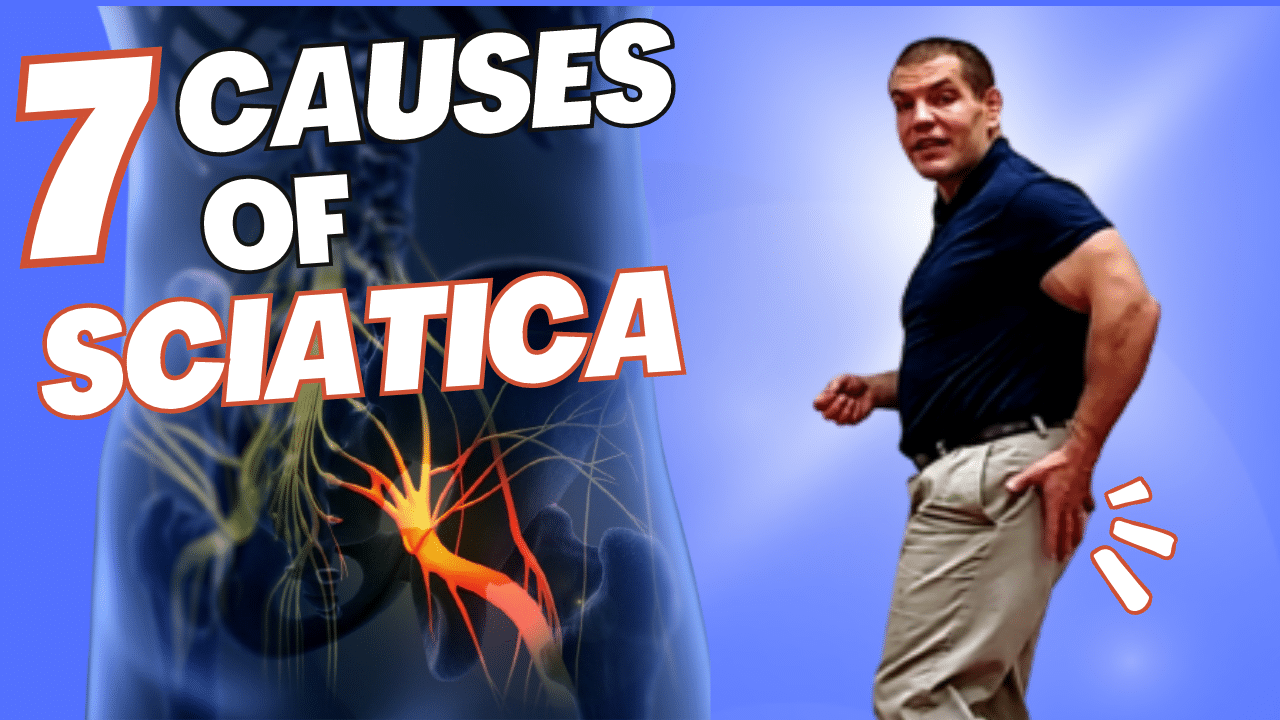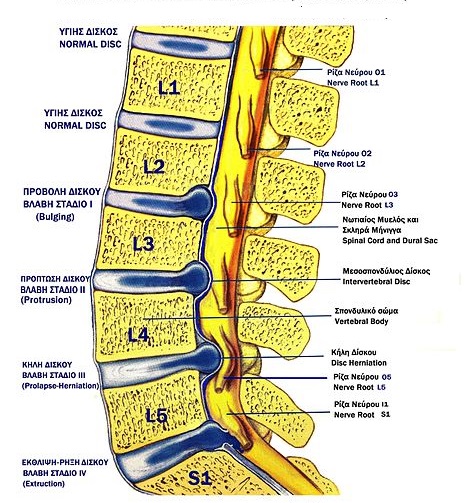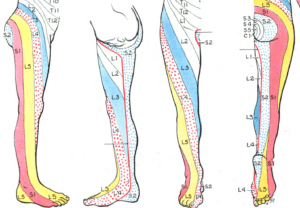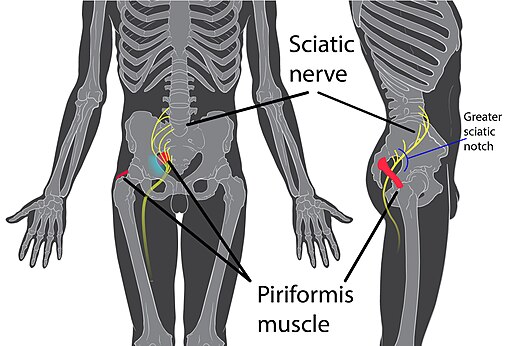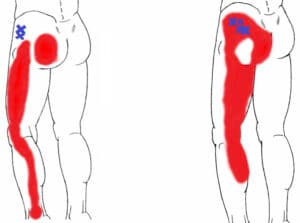If you've recently developed sciatica, you may wonder what causes it, and what you can do to get rid of it. Watch the video to learn 7 different causes of sciatica plus what to do for them.

What Causes Sciatica?
Sciatica is an incredibly common problem, and there's a good reason for it....
Sciatica is NOT something simple and concrete.
In fact, it's not just one thing...
There can be many different causes of sciatica.
All sciatica really means is pain in your back, your buttock, down your leg, or in the calf, or any combination thereof between those.
It's more of a symptom rather than a diagnosis.
Therefore, a diagnosis of sciatica doesn't get you any closer to finding a cure for it.
So, the first thing that you need to do to help get your sciatica better is to figure out what's causing it.
That's what I'm going to walk through in this post.
7 Causes Of Sciatica
- Pinched Nerve In Your Back
- Back Muscles and Joints
- Hip Joint or SI Joint
- Piriformis Syndrome
- Hip Muscles
- Hamstrings
- Common Peroneal (Fibular) Nerve
I'll start from the most common causes to the least common causes. You'll also notice that these generally follow a top-to-bottom order.
Sciatica From A Pinched Nerve In Your Back
The most common thing that causes sciatica is a back problem.
If I had someone walk into the office and say, "Hey, I've got this pain in my buttock and my leg and not in my calf," the very first thing that I would think of is a back problem.
Back problems are by far the most common cause of sciatica.
But even within that subcategory, there are a lot of different things within your back that can give you symptoms of sciatica.
For example, you can have a bulging disc or a herniated disc or degenerative disc in your back that pushes on the nerve roots that make up your sciatic nerve.
These nerve roots can then cause sciatica symptoms. The location of the symptoms will depend on which nerve root is pinched.
However, you don't actually have to have those on your MRI in order to have symptoms of sciatica.
Patients get really frustrated when they have all this pain that's going down their leg, and they go to the doctor, and they get an MRI, and they say, "It looks fairly normal."
That's good news, but it can kind of frustrate people because they want something concrete on an image that they can point at and say, "That's causing my sciatica."
The opposite holds true as well.
That sometimes people have things that just naturally appear on MRIs like bulging discs or herniated discs or degenerative discs, and those happen in a lot of people without any pain.
But when they appear on an MRI of someone who does have pain, there's a natural tendency to associate that thing that they saw on the MRI with the symptom they're having when, in fact, that may or may not be the true cause.
If you do have something in your back that's causing sciatica, you really need to determine what causes it.
For example, is it a problem of your spine being too arched or too flat?
Either one of those can cause sciatica.
So in order to find the right treatment, you really have to figure out which one of those problems it is.
Request a Discovery Visit to discovery what's causing your sciatica.
Sciatica From Your Lower Back Joints And Muscles
To make it even a little bit more complex, your back muscles and joints can actually cause symptoms that refer down into your butt and down into your thigh.
Here's a diagram of joint referral patterns from a 2009 article in PAIN®.
This picture above shows the referral pattern of the joints themselves, not the nerve roots.
Additionally, the muscles in your lower back can refer pain down into your buttock and thigh.
Trigger Point Wall Chart - Buy On Amazon
Usually, back muscle pain doesn't go past the knee.
What I think of when I hear sciatica is pain in the butt, back of the leg, and then down into the lower leg as well.
However, some people will refer to buttock pain as sciatica.
Some people actually call pain in the front of your thigh sciatica as well, even though that's actually from your femoral nerve.
But sciatica is not a very clear term among the lay public or among the medical community.
That's one of the reasons why it's such a common problem: because there's no real agreement on what exactly the term means to begin with.
So let's move down from the back.
Sciatica From Your SI Joint
Next, we move down to your pelvis.
The Sacroiliac joints (or SI joints) are where your spine joins with your pelvis.
You can see the proximity of the SI joints to the sciatic nerve.
Therefore, SI joint pain can cause symptoms similar to sciatica even if the sciatic nerve isn't being compressed.
However, when there is an SI joint dysfunction, that can cause a spasm in the muscles that attach to your pelvis.
One of those muscles is the infamous piriformis.
Piriformis Syndrome
The piriformis is one of 6 hip external rotators. The sciatic nerve runs underneath of the piriformis, and in 10-20% of the population, the sciatic nerve actually runs through the piriformis.
After passing through the piriformis, the sciatic nerve exits the pelvis and runs just outside the bones that you sit on.
Therefore, if you spend a lot of time sitting, particularly if you sit more on one cheek than more than the other, that can put pressure on the sciatic nerve in the buttock.
People who have a compression of their sciatic nerve at the pelvis will often try to stretch their piriformis.
But stretching your piriformis isn't necessarily always the greatest idea.
Sometimes sciatica pain from your hip or "piriformis syndrome" can be caused by a piriformis that's too stiff and needs to be stretched.
At other times, it's actually caused by that muscle being chronically overlengthened. Therefore, further stretching out that muscle isn't going to help. It might even make it a little bit worse.
So you really need to determine whether your piriformis syndrome is coming from a piriformis that's too short and stiff or from piriformis that's been chronically overstretched.
Sciatica Caused By Hip Muscles
If you move down from the pelvis, your hip muscles can actually cause sciatica symptoms.
For example, the gluteus medius and gluteus minimus trigger points can refer pain down your leg in a pattern matching the L5 and S1 nerve roots from your lower back.
Therefore, you could easily mistake a gluteal muscle problem for sciatica.
And if you treat a hip problem like a back problem, then it probably won't get better.
That's why it's really important to find the cause of your sciatica
Sciatica Caused By Your Hamstrings
The sciatic nerve runs deep to your hamstrings, so if you have stiff hamstrings, that can put pressure on the sciatic nerve.
However, stretching stiff hamstrings may be bad for sciatic sciatica.
If you have sciatica, when you stretch your hamstrings, you're just putting tension on an already irritable sciatic nerve.
And that can actually kind of irritate the problem even more.
The same thing can apply to rolling your hamstrings on a foam roller as well.
If the sciatic nerve is already irritable and then you mash down on it by rolling your hamstrings on a foam roller, you just make the sciatic nerve more irritable.
Instead, try rolling your quadriceps and stretching your hip flexors.
Additionally, you might try doing sciatic nerve glides in a range of motion that doesn't cause pain.
Sciatica From Your Calf Muscles and Common Peroneal (Fibular) Nerve
Now moving down into the lower leg there's a trigger point in the back of your soleus muscle that can refer pain up to your lower back.
It's not so common that muscles are for pain closer to the spine, but this trigger point actually does refer pain up into the butt and the SI joint.
Maybe not so coincidentally, there's also a branch of your sciatic nerve that runs right through this area called the common fibular (a.k.a common perineal) nerve.
And that trigger point in your soleus is right along that pathway of the common perineal nerve.
People who have trouble with that area there that stabilizing the joint between the two bones in the lower leg can help give you some relief.
Additionally, some trigger point therapy or dry needling to the soleus can be helpful.
Conclusion
Just to review, if you are having symptoms of sciatica, they may be caused by several different things.
Your symptoms may be caused by nerves, muscles or joints in your back, in your hip, or in your leg.
That's a lot to unpack, and it's hard to face that all by yourself.
So if you need help for sciatica and you live in the St. Louis area, just tap the button below to request an appointment with one of our specialists.
We'll help you figure out what's causing your sciatica and what you can do to relieve it.
And if you're somewhere else in the world but you need more clarity to figure out what's causing your sciatica and some things you can do at home to relieve your symptoms, check out my Relieve Sciatic Nerve Pain At Home Online Course.

